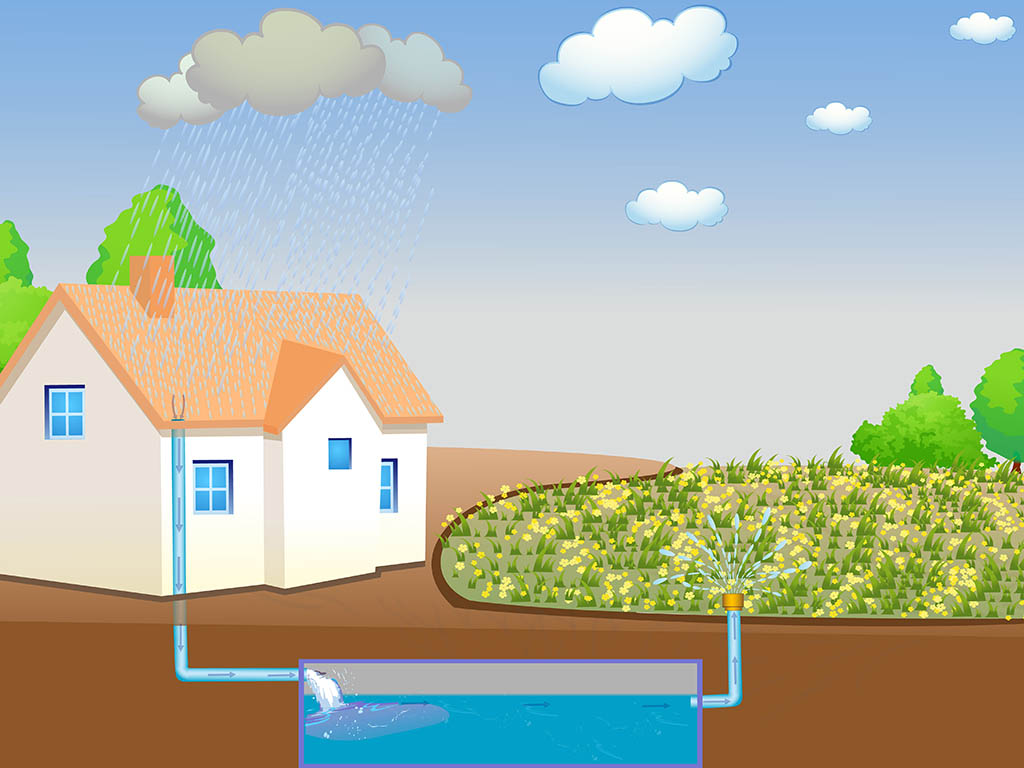Water is, undoubtedly, the top natural resource you need for your home use. It’s glamorous to possess a stockpile of guns, gold, and jeweler, but without water, life might prove to be unbearable. Water shortages are sometimes inevitable, and so if you’re not prepared for the eventuality, you might find yourself between a rock and a hard place. The best and cheapest alternative to the traditional water supply systems is rainwater harvesting. However, to be able to harvest rainwater, you’ll need to install a rainwater harvesting system.
We all take water for granted. It is one of those natural resources that most people do not put a lot of thought into, but in order to continue enjoying that free supply of water for many more years, changes must be made. Rainwater harvesting is the process of collection of rainwater from surfaces on which rain falls, filtering it and storing it for multiple uses. Rainwater harvesting puts the supply of water back to normal levels. It is the collection and storage of water from surfaces that rain has fallen upon.
Rainwater harvesting is an innovative technique utilized to harvest rainwater from roofs and other above surfaces to be stored for later use. Rain harvested water can be used for garden and crop irrigation, watering livestock, laundry, and flushing toilets. However, you cannot use harvested rainwater for showering, bathroom sink or kitchen use because it’s not really fit for consumption.
In a normal scenario the rainwater is collected from roof buildings and then stored inside of a special tank. Rainwater harvesting systems are designed after assessing site conditions that include rainfall pattern, incident rainfall, subsurface strata and their storage characteristics. Rainwater harvesting is popular all across the world, although in countries that are very dry, such as Australia, it is even more popular.
Rainwater can be harvested and used by those in the city who have running city water just as well as it can be used by those in more rural towns where adequate water supply may be unavailable. It is simple to replace many things that you are using regular city water with rainwater and enjoy numerous benefits when you do. Not only it helps you to conserve water but can also help you to save energy as the need to maintain centralized water system can be bypassed.
If you are worried about your roof being dirty, put that fear to the side. Many different tools are available to help you easily clean your roof. Hiring a roofer to com provide you with a cleaning is another option that you will have available.
Individuals are driven to harvest rainwater because of a wide range of factors such as unpredictable weather patterns, enhanced costs of infrastructure and explosion of water consumption. On top of that, most businesses and homes are looking to embrace green practices to become efficient and a lot more self-reliant. In this case, rainwater presents the obvious choice because it is the easiest and quickest method to minimize water consumption. Most homeowners that have embraced this practice have reported a reduction of about 50% in water bills. On top of helping to reduce water bills, rainwater harvesting helps the environment a lot.
Benefits of Rainwater Harvesting
The collection of rainwater and harvesting it for everyday use has an ample number of exciting benefits. Let’s take a look and discover some of those benefits.
Provides backup source of water
There are many uncertainties in water supply systems. Droughts may lead to shortage of water. Destruction of water supply systems may occur at specific locations. Major repairs and maintenance in water companies happen sporadically. All these variables lead to unavailability of water in your home. So, installing rainwater harvesting system is the best course of action to continue enjoying water supply in case any of the above variables occur.
The collected rainwater can be used for many different purposes around the home. This includes laundry, washing dishes and more. This would prevent groundwater depletion and augment ground water table.
Ecological benefit
The ecological benefits of rainwater harvesting are immense. An activity like flushing the toilet, for instance, attributes to about 35% of home water usage. Add up the amount of water used to irrigate the lawn, do laundry, wash cars and the total amount water used is simply astronomical. For businesses, more so hospitality establishments that accommodate a big number of guests in a single location, require a lot of water to satisfy customers. Rainwater harvesting will simply help to fill this gap.
The ecological benefit rainwater harvesting systems bring is that there will be a significant reduction in the amount of water used from the mains. This, ideally, means that water companies will not have to artificially pump in water from rivers and lakes. This will help minimize the possibility of rivers drying up. Another great ecological benefit of rainwater harvesting systems is that they help reduced the load placed upon drainage systems, minimizing the impacts of flooding by funneling the runoff water into large tanks for recycling.
Easy to maintain
Rainwater harvesting systems are considerably easy to maintain since they are not utilized for drinking, cooking or other sensitive uses. This means that they will not need installation of purification systems, which are usually expensive.
Rainwater harvesting systems are cost effective, provide high quality water, reduce dependence on wells. The surplus rainwater can also be used to recharge ground water aquifer through artificial recharge techniques.
Reduces erosion and flooding around buildings
Most buildings that utilize rainwater harvesting systems have a built-in catchment area on top of the roof, which is capable of collecting vast amounts of water in case of rain storms. It helps to reduce soil erosion as by capturing rainwater, the flow of storm water is reduced which can also prevent urban flooding. If the water were not collected efficiently, it could have resulted in serious soil erosion and flooding around the house.
Requires low upfront capital investment
Installation of rainwater harvesting system is not that expensive, plus it’s a one-time installation, and that’s it. The only routine maintenance required is cleaning out the tank. You will probably hire an expert technician to install the system for you. The technician won’t quote a high price, plus he will offer free advice on the best rainwater system to buy. He will also help out when buying the system to ensure you get the best quality rainwater harvesting system. When you sum up the overall cost of installing the system, you’ll find that it’s actually manageable.
Once you begin using rainwater you will also appreciate a reduced amount of water consumption in the home, thus all of your utility bills will greatly shrink in size. How incredible would it be to slash as much as 50 to 60% off of your water bill each month? No complaints with having additional money in the pocket each and every month.
Ad by Valueimpression
Rainwater Harvesting Methods
It is simple to collect rainwater from building roofs and numerous other sources. As long as you are ready and equipped with a couple of different items you have all that it takes to begin rainwater harvesting and enjoying naturally delicious, clean and useful water. Rainwater harvesting systems can be purchased complete from various home improvement stores. The cost of these systems will vary.

Save
Take a look at some of the techniques of rainwater harvesting for yourself.
Rainwater barrels
Barrel installation is the cheapest and easiest way to start harvesting rainwater in your home. A barrel is simply installed underneath the downspout of the guttering so that rain falling on the roof is funneled into the barrel. Usually, the container will consist of a spigot under it to enable you draw water and irrigate your garden. Better still; a hose can be connected to the spigot or to a drip irrigation system.
Barrels are advantageous because they can effortlessly be sourced whether recycled or new. If you opt for the recycled barrel, make a point to know exactly what the barrel was used for in order to be sure that no chemical residues remain inside. If you reside in a mosquito infested area, make sure to include a lid for your barrel to mitigate the possibility of mosquitoes breeding in your barrel.
When winter month knocks, it is advisable to disconnect your barrel to prevent freezing and cracking. The major disadvantage to rain water barrels is that they have limited capacity; meaning prolonged rains would result in flooding. The barrels are easy to use and readily available for purchase at many locations, all at reasonable prices.
Dry system
This is a well-known method of rainwater harvesting. It’s basically an improvement to the rain water barrel technique in terms of size. A larger water storage container is situated just a few steps from the property. This container provides a much larger storage capacity compared to the barrel. The gutter is then diverted to channel water into the tank. It’s also easy to implement and relatively cheap. The name “dry” comes from the fact that the collection pipe dries up after any rainy day because it’s meant to empty into the top of tank. The dry system is ideal for areas with huge storms.
Wet system
The wet system is the exact opposite of the dry system. This is because the collection pipes are ever full of water since they are located underground. Here, numerous collection pipes are connected to multiple downspouts on the building and channeled to empty into the storage tank underground. When there is no rain, the level stays constant, and the pipes are always full. Due to the ever availability of water inside the pipes, it is recommended that they be watertight to mitigate the possibility of leaking into the soil. The underground piping makes it relatively expensive to install compared to the dry and wet systems.
Green roof
This method of rainwater harvesting literally cuts out the middleman. Instead of directing rainwater for storage in the tank and then channel it to the garden; you could install a green roof on your house to enable plants use the water instantly. But you have to lay down a lining for your roof’s protection and include a drainage system to take care of the runoffs. Installing garden beds with plants that require low maintenance is the surefire way of maximizing your plot’s productive space and leveraging the rainwater where it falls. Also, installing a green roof will add insulation to your house and cushion your roof from damage.
If you prefer you can create your own barrels for rainwater harvesting. Just a few components like Catchment area, conveyance system, first rain separator, filter unit, storage, delivery system, usage, recharge and supplies are needed to create your own barrel.
You will need to follow the instructions included with your rainwater harvesting kit to set things up and begin collection of the rainwater. For a DIY job, there are many resources available to you on the internet at no charge. You can definitely take advantage of the information whenever you need to and create your own rainwater harvesting system.
Conclusion
Ad by Valueimpression
Rainwater harvesting is something that thousands of families across the world participate in, and you could be the next to enjoy the multitude of benefits offered with rainwater harvesting. It is an easy, simple and worthwhile process, so it is only in your best interest to take a look at rainwater harvesting and its benefits to your home. You may discover many surprises and things that you did not know along the way!


